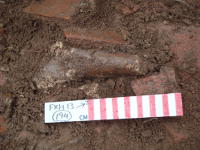29 Mar 2015
Midden Dig News

It's been a long and extremely wet weekend, but we got the job done; although the archaeology didn't quite turn out as expected we have confirmed the presence of the (presumed palace) midden and added a little to our understanding of its nature, though unfortunately definitive dating evidence is still elusive.
As planned, we opened two trenches at the far end of the lime tree avenue in Forty Hall, directly next to Maidens Brook, both targeting the dense bone deposit we've seen before in the 'Greenway' cycle track and the new HLF footbridge installation.
It quickly became clear on Saturday that the westernmost trench did not contain any sign of a midden, or indeed any palace archaeology -- this trench was sited on the edge of the remains of an eighteenth century water feature, (an ornamental reservoir once dammed and filled by the brook) and our trench revealed extensive twentieth-century disturbance probably related to the revetment of the reservoir and possibly the installation of the gas main which runs nearby -- meaning that any earlier archaeology has been cut away.
This meant that we could close the western trench early and focus on the eastern trench, but heavy rain and high winds all day on Sunday made it slow and messy work.

We eventually identified the midden context, which lay under a dense layer of palace rubble, the vast majority of which was roof tile fragments. The midden layer itself was, in this trench, very thin and only extended across about half of the trench, suggesting the trench was located right on the edge of the midden dump, which thinned out as it approached the bank of the brook.
We did recover several large fragments of bones; mostly cow bones (pictured) including part of a jaw with all its teeth intact, and also a few horse teeth.
Frustratingly, there was no definitive dating evidence from the limited exposure of midden context we saw -- although we did find a few pot sherds they were mostly in and above the rubble layer. Hopefully, it may be possible to deduce more about the date of deposition of the midden during post-excavation -- results of this will as usual appear in future issues of Society News.
In unrelated parts of the easternmost trench we did find two small prehistoric flint tools, which helped to cheer up one or two bedraggled diggers. Many thanks to those of you who turned out to help and we look forward to seeing you again in another muddy hole soon!